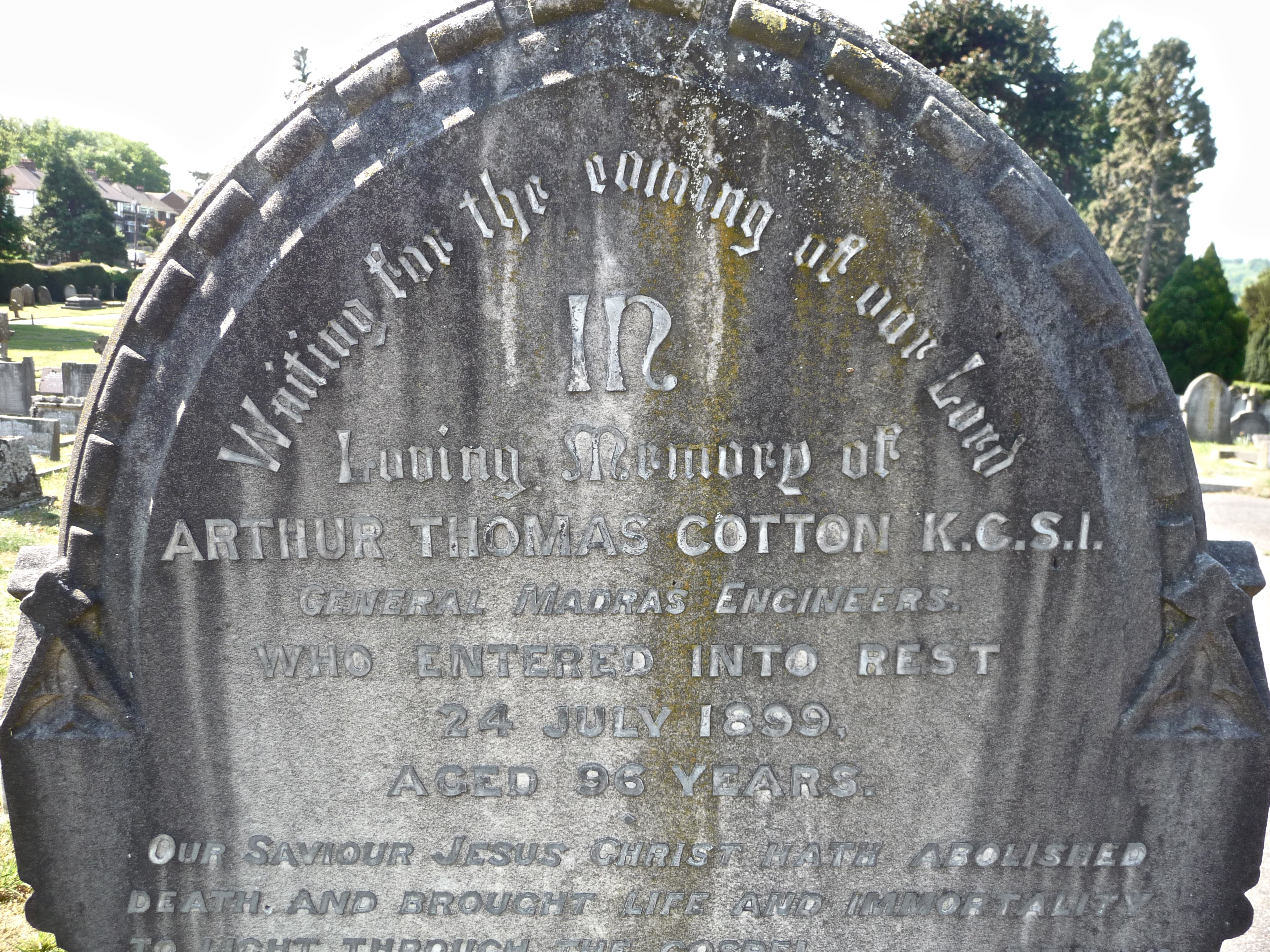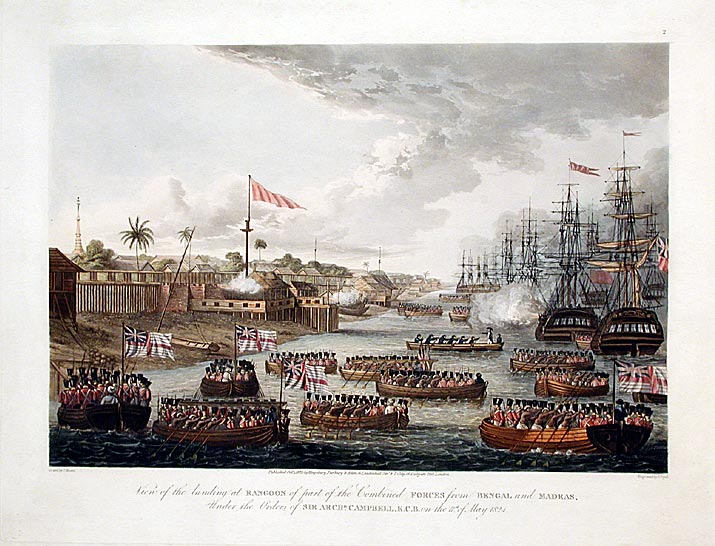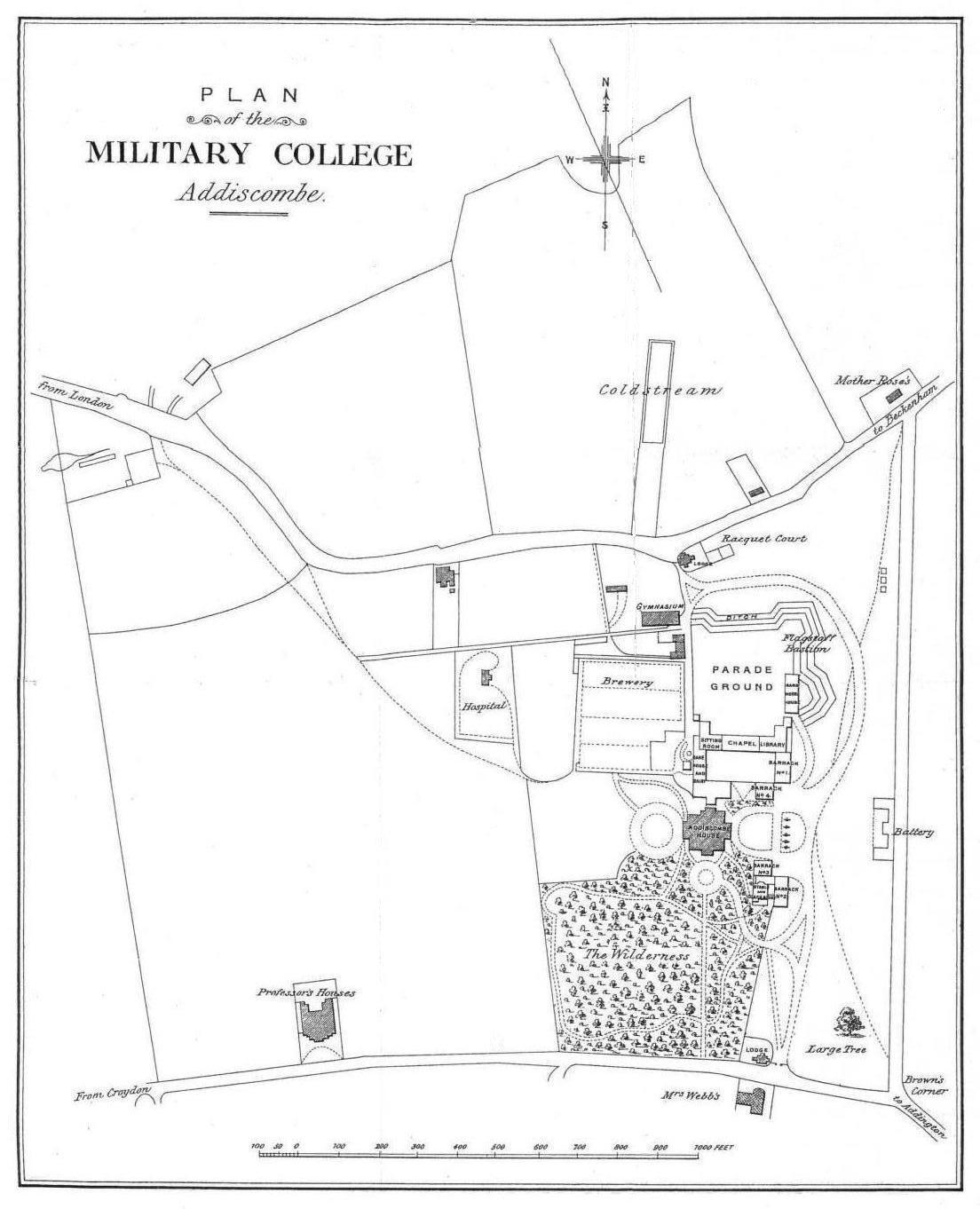|
Arthur Thomas Cotton
General Sir Arthur Thomas Cotton (15 May 1803 – 24 July 1899) was a British army officer and irrigation engineer who worked in the Madras Presidency. Cotton devoted his life to the construction of irrigation and navigation canals throughout British India. He helped many people by building the Dowleswaram Barrage (Rajahmundry), the Prakasam Barrage, and the Kurnool Cuddappah Canal (K. C. Canal). His dream was only partially realised, but he is still honoured in Andhra Pradesh and parts of Tamil Nadu for his efforts. The Sir Arthur Cotton Museum has been built in his honour in Rajamahendravaram, Andhra Pradesh. The museum holds approximately one hundred images and 15 machine tools that Cotton used when constructing the barrage in Andhra Pradesh from 1847 to 1852. He was the father of the evangelist Elizabeth Hope. Biography Arthur Cotton was born on 15May 1803 at Combermere, the tenth son of Henry Calvely Cotton, uncle of the noted Field Marshal Lord Combermere, and o ... [...More Info...] [...Related Items...] OR: [Wikipedia] [Google] [Baidu] |
Combermere Abbey
Combermere Abbey is a former monastery, later a country house, near Burleydam, between Nantwich, Cheshire and Whitchurch, Shropshire, Whitchurch in Shropshire, England, located within Cheshire and near the border with Shropshire. Initially Congregation of Savigny, Savigniac and later Cistercian, the abbey was founded in the 1130s by Hugh Malbank, Baron of Nantwich, and was also associated with Ranulf de Gernon, 4th Earl of Chester, Ranulf de Gernons, Earl of Chester. The abbey initially flourished, but by 1275 was sufficiently deeply in debt to be removed from the abbot's management. From that date until its Dissolution of the Monasteries, dissolution in 1538, it was frequently in royal custody, and acquired a reputation for poor discipline and violent disputes with both lay people and other abbeys. It was the third largest monastic establishment in Cheshire, based on net income in 1535. After the dissolution it was acquired by Sir George Cotton, who demolished the church and mos ... [...More Info...] [...Related Items...] OR: [Wikipedia] [Google] [Baidu] |
Elizabeth Cotton, Lady Hope
Elizabeth Reid Cotton, (9 December 1842 – 8 March 1922) who became Lady Hope when she married Sir James Hope in 1877, was a British evangelist active in the Temperance movement. In 1915, she claimed to have visited the British naturalist Charles Darwin shortly before his death in 1882. Hope said that Darwin spoke of second thoughts about publicizing his theory of natural selection. The possibility that Hope visited Darwin cannot be excluded, although it is denied by Darwin's family, but what she claimed Darwin said at the putative interview is much less likely to be accurate. Early life and ministry Elizabeth Cotton was born on 9 December 1842 in Tasmania, Australia. She was the daughter of British irrigation engineer, General Sir Arthur Cotton, and spent her childhood in Madras, India, while her father supervised water management and canal projects in Andhra Pradesh. Returning to England after her father's retirement in 1861, the family resided in Hadley Green and came u ... [...More Info...] [...Related Items...] OR: [Wikipedia] [Google] [Baidu] |
Cauveri
The Kaveri (also known as Cauvery) is a major river flowing across Southern India. It is the third largest river in the region after Godavari and Krishna. The catchment area of the Kaveri basin is estimated to be and encompasses the states of Tamil Nadu, Karnataka, Kerala, and the union territory of Puducherry. The river rises at Talakaveri in the Brahmagiri range in the Western Ghats. The source is located at an elevation of in the Kodagu district of Karnataka. The river flows for about through the Deccan plateau in Karnataka before entering Tamil Nadu. It flows further eastward in Tamil Nadu for before flowing into the Bay of Bengal near Poompuhar in Mayiladuthurai district of Tamil Nadu. The river flows for a total length of about . The major tributaries include Amaravati, Arkavati, Bhavani, Hemavati, Kabini, Lakshmana Tirtha, and Noyyal. There are a number of dams on the river which form part of an extensive irrigation system and are used for the generation of hy ... [...More Info...] [...Related Items...] OR: [Wikipedia] [Google] [Baidu] |
Ceylon
Sri Lanka, officially the Democratic Socialist Republic of Sri Lanka, also known historically as Ceylon, is an island country in South Asia. It lies in the Indian Ocean, southwest of the Bay of Bengal, separated from the Indian subcontinent, Indian peninsula by the Gulf of Mannar and the Palk Strait. It shares a maritime border with the Maldives in the southwest and India in the northwest. Sri Jayawardenepura Kotte is the legislative capital of Sri Lanka, while the largest city, Colombo, is the administrative and judicial capital which is the nation's political, financial and cultural centre. Kandy is the second-largest urban area and also the capital of the last native kingdom of Sri Lanka. The most spoken language Sinhala language, Sinhala, is spoken by the majority of the population (approximately 17 million). Tamil language, Tamil is also spoken by approximately five million people, making it the second most-spoken language in Sri Lanka. Sri Lanka has a population of appr ... [...More Info...] [...Related Items...] OR: [Wikipedia] [Google] [Baidu] |
Pamban
Pamban is a town in the Rameswaram taluk of Ramanathapuram district, Tamil Nadu. It is at the west edge of Pamban Island and is a popular fishing port. The town gives its name to the whole island. Pamban railway station is the first station on the island for pilgrims travelling to Rameswaram. Demographics As per the 2011 census, Pamban had a population of 37819 with 19163 males and 18656 females. The sex ratio was 974 and the literacy rate was 85.16%. Climate Pamban has a tropical savanna climate (Köppen climate classification ''As'') with hot summers and cool winters. Unlike most locations in India with this climate, most rainfall occurs in autumn and winter, with the heaviest rain falling from October to December, and very little rain in the summer months of June to August. Transport Pamban Bridge is a long railway bridge which connects the town of Mandapam in mainland India with Pamban Island, and Rameswaram. Opened on 24 February 1914, it was India's first s ... [...More Info...] [...Related Items...] OR: [Wikipedia] [Google] [Baidu] |
Arthur Cotton 1900
Arthur is a masculine given name of uncertain etymology. Its popularity derives from it being the name of the legendary hero King Arthur. A common spelling variant used in many Slavic, Romance, and Germanic languages is Artur. In Spanish and Italian it is Arturo. Etymology The earliest attestation of the name Arthur is in the early 9th century Welsh-Latin text ''Historia Brittonum'', where it refers to a circa 5th century Romano-British general who fought against the invading Saxons, and who later gave rise to the famous King Arthur of medieval legend and literature. A possible earlier mention of the same man is to be found in the epic Welsh poem ''Y Gododdin'' by Aneirin, which some scholars assign to the late 6th century, though this is still a matter of debate and the poem only survives in a late 13th century manuscript entitled the Book of Aneirin. A 9th-century Breton landowner named Arthur witnessed several charters collected in the '' Cartulary of Redon''. The Irish borrow ... [...More Info...] [...Related Items...] OR: [Wikipedia] [Google] [Baidu] |
Madras
Chennai, also known as Madras ( its official name until 1996), is the capital and largest city of Tamil Nadu, the southernmost state of India. It is located on the Coromandel Coast of the Bay of Bengal. According to the 2011 Indian census, Chennai is the sixth-most-populous city in India and forms the fourth-most-populous urban agglomeration. Incorporated in 1688, the Greater Chennai Corporation is the oldest municipal corporation in India and the second oldest in the world after London. Historically, the region was part of the Chola, Pandya, Pallava and Vijayanagara kingdoms during various eras. The coastal land which then contained the fishing village Madrasapattinam, was purchased by the British East India Company from the Nayak ruler Chennapa Nayaka in the 17th century. The British garrison established the Madras city and port and built Fort St. George, the first British fortress in India. The city was made the winter capital of the Madras Presidency, a ... [...More Info...] [...Related Items...] OR: [Wikipedia] [Google] [Baidu] |
Chief Engineer
A chief engineer, commonly referred to as "Chief" or "ChEng", is the most senior licensed mariner (engine officer) of an engine department on a ship, typically a merchant ship, and holds overall leadership and the responsibility of that department. In rank, a chief engineer is equivalent to the rank of a ship's captain. As a person who holds one of the most senior roles on the ship, they must have excellent communication and leadership skills. They will be expected to regularly work alongside other crew members and external consultants, and most importantly, provide guidance to their team. To be a chief engineer, an engineer must attain a chief engineer's license appropriate to the tonnage, power rating, and type of ship the engineer is employed on. A chief engineer is ultimately responsible for all operations and maintenance that has to do with any and all engineering equipment throughout the entire ship, and supervises all other engineering officer and engine ratings within the ... [...More Info...] [...Related Items...] OR: [Wikipedia] [Google] [Baidu] |
Bangor, Gwynedd
Bangor (; ) is a City status in the United Kingdom, cathedral city and Community (Wales), community in Gwynedd, north Wales. It is the oldest city in Wales. Historic counties of Wales, Historically part of Caernarfonshire, the community had a population of 15,060 at the 2021 United Kingdom census, 2021 census, and the built up area had a population of 16,990. Landmarks include Bangor Cathedral, Bangor University and Garth Pier. The Britannia Bridge, Britannia and Menai Suspension Bridge, Menai Suspension bridges connect the city to the Anglesey, Isle of Anglesey. History The origins of the city date back to the founding of a monastic establishment on the site of Bangor Cathedral by the Celtic saint Deiniol in the early 6th century AD. itself is an old Welsh word for a wattled enclosure, such as the one that originally surrounded the cathedral site. The present cathedral is a somewhat more recent building and has been extensively modified throughout the centuries. While the ... [...More Info...] [...Related Items...] OR: [Wikipedia] [Google] [Baidu] |
Ordnance Survey
The Ordnance Survey (OS) is the national mapping agency for Great Britain. The agency's name indicates its original military purpose (see Artillery, ordnance and surveying), which was to map Scotland in the wake of the Jacobite rising of 1745. There was also a more general and nationwide need in light of the potential threat of invasion during the Napoleonic Wars. Since 1 April 2015, the Ordnance Survey has operated as Ordnance Survey Ltd, a state-owned enterprise, government-owned company, 100% in public ownership. The Ordnance Survey Board remains accountable to the Secretary of State for Science, Innovation and Technology. It was also a member of the Public Data Group. Paper maps represent only 5% of the company's annual revenue. It produces digital map data, online route planning and sharing services and mobile apps, plus many other location-based products for business, government and consumers. Ordnance Survey mapping is usually classified as either "Scale (map), lar ... [...More Info...] [...Related Items...] OR: [Wikipedia] [Google] [Baidu] |
First Burmese War
The First Anglo-Burmese War (; ; 5 March 1824 – 24 February 1826), also known as the First Burma War in English language accounts and First English Invasion War () in Burmese language accounts, was the first of three wars fought between the British and Burmese empires in the 19th century. The war, which began primarily over the control of what is now Northeastern India, ended in a decisive British victory, giving the British total control of Assam, Cachar, Manipur and Jaintia as well as Arakan Province and Tenasserim. The Burmese submitted to a British demand to pay an indemnity of one million pounds sterling, and signed a commercial treaty. The war was one of the most expensive in British Indian history. Fifteen thousand European and Indian soldiers died, together with an unknown number of Burmese military and civilian casualties. The high cost of the campaign to the British, 5–13 million pounds sterling (£ – £ as of ) contributed to a severe economic crisis ... [...More Info...] [...Related Items...] OR: [Wikipedia] [Google] [Baidu] |
Addiscombe Military Seminary
The East India Company Military Seminary was a British military academy at Addiscombe, Surrey, in what is now the London Borough of Croydon. It opened in 1809 and closed in 1861. Its purpose was to train young officers to serve in the East India Company's Presidency armies, own army in India. The institution was formally known as the East India Company Military Seminary (a name the cadets always disliked) until 1855, when the name was changed to the East India Company Military College.Bourne 1979, p. 206. In 1858, when the college was taken over by the government, it was renamed the Royal India Military College. Colloquially, it was known as Addiscombe Seminary, Addiscombe College, or Addiscombe Military Academy. The Seminary was a sister institution to the East India Company College in Hertfordshire, which trained civilian "writers" (clerks). In military terms it was a counterpart to the Royal Military Academy, Woolwich, Royal Military Academy at Woolwich and the Royal Military ... [...More Info...] [...Related Items...] OR: [Wikipedia] [Google] [Baidu] |









